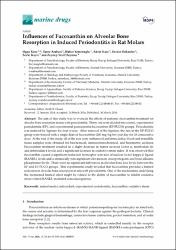Influences of fucoxanthin on alveolar bone resorption in induced periodontitis in rat molars

Göster/
Erişim
info:eu-repo/semantics/openAccessTarih
2016Yazar
Köse, OğuzArabacı, Taner
Yemenoğlu, Hatice
Kara, Adem
Özkanlar, Seçkin
Kayış, Şevki
Duymuş, Zeynep Yeşil
Üst veri
Tüm öğe kaydını gösterKünye
Kose, O., Arabaci, T., Yemenoglu, H., Kara, A., Ozkanlar, S., Kayis, S., Duymus, Z.Y. (2016). Influences of fucoxanthin on alveolar bone resorption in induced periodontitis in rat molars. Marine Drugs, 14(4), article 70. https://doi.org/10.3390/md14040070Özet
The aim of this study was to evaluate the effects of systemic fucoxanthin treatment on alveolar bone resorption in rats with periodontitis. Thirty rats were divided into control, experimental periodontitis (EP), and experimental periodontitis-fucoxanthin (EP-FUCO) groups. Periodontitis was induced by ligature for four weeks. After removal of the ligature, the rats in the EP-FUCO group were treated with a single dose of fucoxanthin (200 mg/kg bw) per day for 28 consecutive days. At the end of the study, all of the rats were euthanized and intracardiac blood and mandible tissue samples were obtained for biochemical, immunohistochemical, and histometric analyses. Fucoxanthin treatment resulted in a slight decrease in tumor necrosis factor-alpha, interleukin-1 beta, and interleukin-6 levels and a significant decrease in oxidative stress index. It was observed that fucoxanthin caused a significant reduction in receptor activator of nuclear factor kappa-beta ligand (RANKL) levels and a statistically non-significant elevation in osteoprotegerin and bone-alkaline phosphatase levels. There were no significant differences in alveolar bone loss levels between the EP and EP-FUCO groups. This experimental study revealed that fucoxanthin provides a limited reduction in alveolar bone resorption in rats with periodontitis. One of the mechanisms underlying the mentioned limited effect might be related to the ability of fucoxanthin to inhibit oxidative stress-related RANKL-mediated osteoclastogenesis.

















